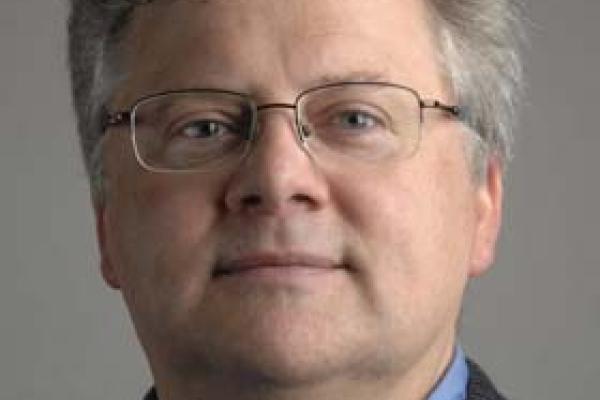For this series, we reach out to a member of the department who has a very particular obsession and ask them to share it with the world. In this edition, Professor Hannibal Hamlin chronologizes his life through music.
When I was 9 years old, I auditioned for a place in a men and boys choir in an Anglican (=Episcopal) church in Toronto. I got in, and so began my musical career and my obsession with music. Of course, I’d probably enjoyed music before that, but I don’t remember much. As a choirboy, I had rehearsals every Tuesday and Thursday night, a private singing lesson on Saturday, and two services on Sunday. We also sang extra services on holydays, visited other Canadian churches, and performed special concerts. We even did some TV spots, including a Christmas show with the opera singer Maureen Forrester. Another Christmas special was filmed in Sherbrooke Quebec, where an unusually mild winter forced the crew to create a patch of artificial snow where we threw snowballs and sang carols. TV struck me as weird, since back then all the music was prerecorded, so for the camera you had to sing or lip sync with a soundtrack.
Music became my life, especially when I started playing clarinet seriously in high school. I was in the concert band, and I learned the tenor sax so I could join the jazz band too. I loved playing clarinet, but it was never quite like singing. There’s no other music making that is so intensely physical, since your body is your instrument, and the sound comes from exhaling the same air we inhale to stay alive. The clarinet was only invented in the later 18th century, so you also don’t have any repertoire before Mozart. Vocal music, on the other hand, probably goes back to before we came down from the trees. For a range of what the human voice can do, listen on YouTube to
Inuit throat singing,
Le Mystère des Voix Bulgares,
Ladysmith Black Mombazo, the
Russian oktavists (basses) or the
King’s Singers doing a Greek traditional song.
To me, the most exciting music is made by people singing together. A full-voiced mass choir can bring tears to your eyes (check out the entire stadium wailing out the hymn
Cwm Rhondda at a Welsh-English rugby match). And there is stunning music for large choirs. I remember hearing Sergei Rachmaninoff’s
Vespers sung by the Czech Philharmonic Choir in the immense Orthodox Cathedral of the Transfiguration near Markham Ontario. The church was the pet project of a Uranium mining millionaire who also raised cattle. It looms over 200 feet into the sky in the middle of nowhere. After an absolutely sublime performance, we walked out into the fields in the dark, with the huge tower bells intoning into the night.
The most exhilarating singing, though, is in small ensembles, where every voice matters: one on a part, two at most. And the best music for this kind of ensemble was written in the Renaissance, from the fifteenth through the seventeenth centuries. As a choirboy, I sang reams of this music, by English composers like Thomas Tallis and William Byrd (who wrote for Queen Elizabeth I), Italians like Giovanni da Palestrina and Andrea Gabrieli, and Spaniards like Tomás Luis de Victoria. Even today, in a pinch, I could probably sing many masses and motets from memory. Musical memory, as Oliver Sacks and other brain scientists confirm, is far deeper than verbal memory, and I will have Orlando Gibbon’s Magnificat and Nunc dimittis (the Short Service) in my head on my deathbed.
When I was in college, my voice long-since changed to a baritone, I started singing more widely, and after graduation I was a full-time musician for a while. I met my wife singing. We did just about every kind of singing that was being sung in Toronto, a very musical city. We even formed our own ensemble to perform the music of two Franco-Flemish composers, Guillaume Dufay and Josquin des Prez. Dufay wrote a
stunning motet lamenting the fall of Constantinople, capital of Eastern Christianity, to the Ottoman Turks in 1453. The upper voices sing in French, a mother lamenting the death of her son to the boy’s father (obviously signifying Mary, Christ, and God). The low voice beneath slowly intones, in Latin, a text from the biblical Lamentations for the fall of Jerusalem. According to one story, the motet was sung at a Burgundian court banquet by a woman in white, representing the fallen city, riding an elephant. Josquin was one of the greatest composers in European history.
One of his most gorgeous pieces is a lament for the death of the earlier composer, Johannes Ockeghem. Calling on the nymphs of the woods to mourn, the song seems secular, but the plaintive music includes excerpts from the plainsong melody of the Requiem. Josquin also has a fun song about a singing cricket,
“el grillo.”
My wife and I taught high school for several years, when we were too busy to do any singing, but when I decided to do a Ph.D., I got back into the music scene in New Haven and New York. I joined the choir of St. Luke in the Fields, which did a lot of early music, sometimes bringing in extra singers or instrumentalists for special services or concerts. We sang a mass by the Netherlandish composer Heinrich Isaac, for instance, with the New York Cornet and Sackbut Ensemble. (The sackbut is an ancestor of the trombone, and the cornet a weird wind instrument with a wooden pipe and a trumpet mouthpiece.) I also did some odd singing jobs around New York, including dressing up like a monk and singing plainchant with the New York Ensemble for Early Music for an NBC feature on the T2K Apocalypse. The weirdest job was singing with the choir of St. Thomas’s, Fifth Avenue, for the christening of the cruise ship, The Grand Princess. On a pier off the lower east side, we shared a stage with the cast of The Love Boat, and Olivia de Havilland, who hurled the champagne.
I don’t do much singing these days, but I’m still passionate about music, especially singing. When it’s done well, it’s one of the greatest accomplishments of our species, which is probably why for so many poets – John Donne and John Milton, for instance – joining the heavenly choir is the ultimate aspiration. And so many poets write about poetry as singing: Whitman sang of himself, and sang the body electric; Homer begged his Muse to sing in him, and so tell the story of Odysseus; Keats dared to stammer where old Chaucer used to sing; Wallace Stevens writes of a woman in Key West who sang beyond the genius of the sea; Dylan Thomas wrote that time held him green and dying, but he sang in his chains like the sea; Emily Dickinson wrote of a bird who sobbed, “My business is to sing”; and Maya Angelou’s titled her autobiography, I Know Why the Caged Bird Sings, borrowing a line from another singing poet, Paul Laurence Dunbar.
I’m not sure if I’m obsessed by music, by singing, since the word originates in being possessed, attacked, even haunted. Music is certainly down deep, though, and feels like a vital part of who I am.


